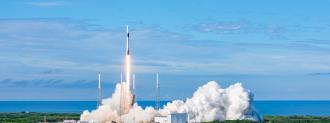For decades, if you wanted to reach space, you had to sacrifice a rocket.
You’d attach your payload to the rocket, and it’d carry the payload high into the sky. Once the rocket ran out of fuel, it’d separate from the payload and either crash back down to Earth, burn up in the atmosphere, or become space junk.
That got the job done, but a single launch could cost tens or even hundreds of millions of dollars, putting space out of reach for anyone without deep pockets — usually, governments or the military — and that’s been holding society back.
“Launch cost has always been the primary constraint in the space business,” Greg Autry, a commercial spaceflight expert, wrote in 2017. “If access to space weren’t so expensive we’d have an astounding amount of entrepreneurial activity in low-earth orbit and beyond.”
“Space tourism, materials development, pharmaceutical research, power generation, communications, earth imaging, and national security all have ‘killer apps’ just waiting for reliable and affordable access to space,” he continued.
Reusable rockets could make that affordable access a reality.
Reusable Rockets for Hire
Reusable rockets are exactly what they sound like — rockets that aren’t limited to a single launch — and Elon Musk’s company SpaceX has been instrumental in their development.
In 2015, SpaceX launched one of its Falcon 9 rockets into orbit and then landed it, upright, back on Earth — a feat five years (and many failed attempts) in the making.
The engineering of the system was complicated (it is rocket science, after all), but the key was giving up on the idea of using parachutes for the return and instead controlling the descent using thrusters.
After the payload separation, thrusters near the top of the rocket flipped around, pushing the whole thing backwards. When the Falcon 9 was just about to reach Earth, its engines fired, slowing the rocket’s descent onto the landing pad.
After repeating that success several more times, SpaceX used one of its recovered Falcon 9 rockets for a 2017 launch, marking the first reuse of a rocket capable of delivering payloads into Earth’s orbit.
We’d have an astounding amount of entrepreneurial activity in space if access weren’t so expensive.
Greg Autry
Since then, the company has relaunched many of its reusable rockets — on November 24, it actually sent one Falcon 9 into space for a history-making seventh time — and it’s no longer the only major player in the space.
Jeff Bezos’s Blue Origin has developed a reusable rocket (New Shepard) that can reach suborbital space, land upright, and then fly again. It’s currently working on one for orbital missions, too (New Glenn).
New Zealand startup Rocket Lab has developed its own reusable rocket (Electron), and on November 20, it successfully recovered one for the first time — a major milestone on the road to reusability.
Cutting Space Exploration Costs
Musk has long touted the potential for reusable rockets to cut launch costs, and it definitely makes sense on paper.
Use a $100 million rocket for one launch, and you need to charge a customer at least $100 million to break even. Use that same rocket for five launches, and you only need to charge $20 million (for the rocket component, anyway — fuel, manpower, and recovery aren’t free, either).
Figuring out exactly how much money the reusable rockets are saving customers per launch is a little harder to parse — some estimates say 40%, others say they’re 66% cheaper than one-time-use rockets.
As more companies successfully develop reusable rockets, market competition could drive prices even lower, and one day, reusable rockets could make space exploration affordable for anyone with an idea for a microgravity experiment — or a desire to vacation above the clouds.
We’d love to hear from you! If you have a comment about this article or if you have a tip for a future Freethink story, please email us at [email protected].






